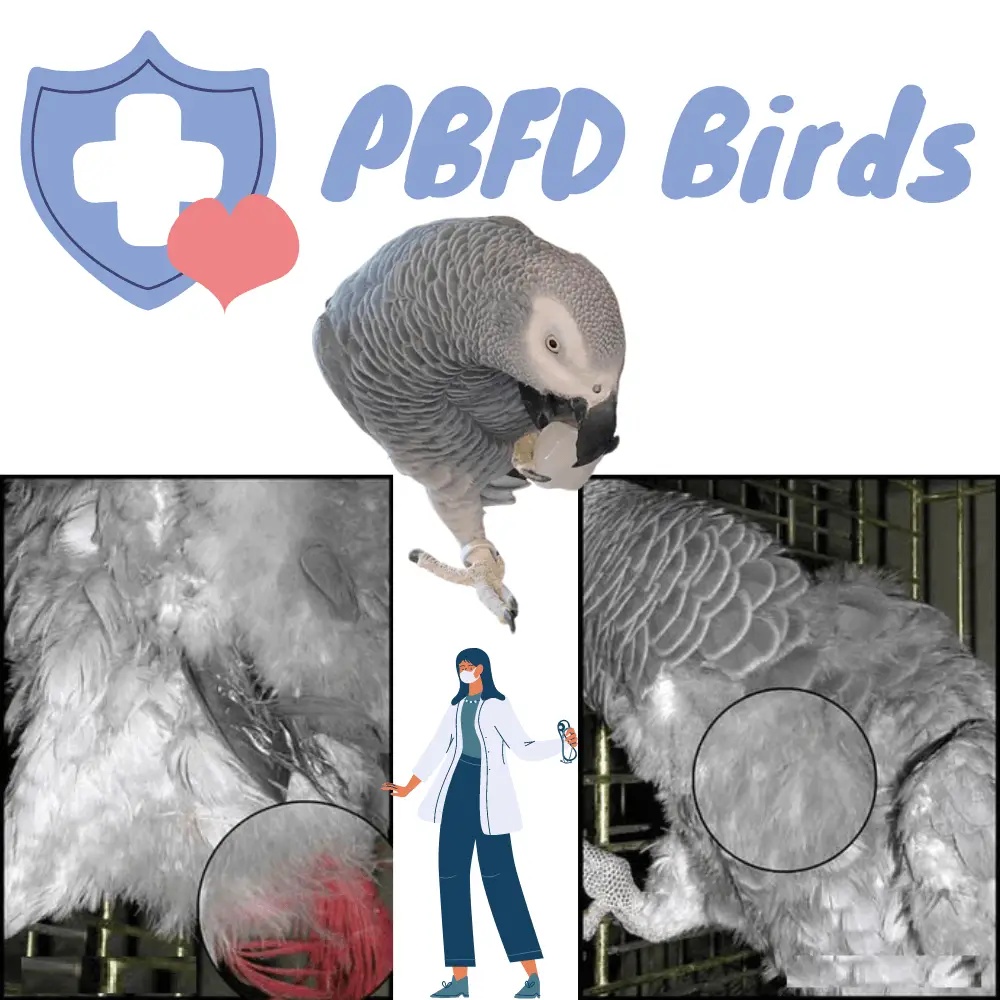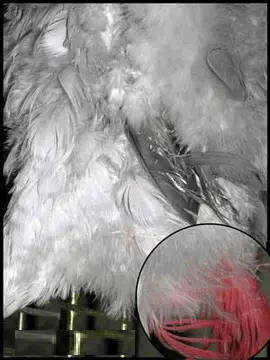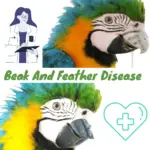
WHICH BIRDS ARE MORE AT RISK of PBFD birds? Psittacine beak and feather disease is caused by a Circovirus and mainly affects species from Australia and Africa, including wavy parakeets, cockatoos, inseparable, and African grey parrot. Eclectus and Coconut lorikeet are also often affected. The virus can affect birds of all ages, but the young are most at risk.
The incubation period varies according to the age of the individuals. In young people, the disease develops very quickly, in 2-4 weeks. In older individuals, the infection tends to be more chronic, and the incubation period varies from a few months to a few years. However, when clinical signs appear, life expectancy is, on average, 6-12 months.
What Is PBFD?
SOURCE:Howcast
TRANSMISSION
Infected birds excrete the virus into the environment through their stool, regurgitation/vomiting, or feather powders. A bird can become infected by ingestion of the virus, but also by inhalation (transmission through the air). Transmission from parents to offspring also seems possible. This mode of transmission is currently being studied. In addition, transmission through indirect contact, i.e. through objects or even through humans who have been in contact with an infected animal, is possible.
CLINICAL SIGNS PATHOGENESIS
The virus induces necrosis of the basal epidermis as well as necrosis, clots, and hemorrhages in the pulp of the feather. This results in deformed, fragile, and easily falling feathers. The virus also attacks the germ cells of the beak, causing its necrosis.
- Red feathers of abnormal distribution in African greys
- Delayed molting
- Dull plumage, fragile feathers, frayed deformed feathers
- Abnormal feather loss Little/no powder on feathers, itching
- Hyperkeratosis/Elongation of the beak (especially in cockatoos).
- Longitudinal cracks may eventually appear.
- Necrosis of the beak and mucosa of the palate.
- Pain in the beak.
- Lethargy Regurgitation
The virus is also found in the blood, where it attacks white blood cells and leads to a decrease in the immune system (immunosuppression). The bird, therefore, becomes very susceptible to different diseases and infections of all kinds.
DETECTION OF THE DISEASE
We can detect the virus in the blood by a PCR (polymerase chain reaction) test, even before signs of disease appear. We can also perform the test with a dystrophic blood feather, however, this test seems less reliable than the first one. All these tests must be done in a hospital following a general examination of the bird.
DISEASE CONTROL
Since there is no precise treatment for the disease and Feather and Beak Disease is fatal in many cases, any new bird should ideally be tested for the disease, especially if several birds are kept at home, or if the bird potentially has contact with other birds such as during boarding or visiting. It is also recommended to perform the PCR test if the origin of the bird is undetermined, doubtful, or at risk. Maintain strict hygiene measures to avoid significant contamination.
Disinfection of the environment is also essential. A complete cleaning should be carried out before any disinfection. As the environmental stability of this virus is not precisely known, it is difficult to give precise recommendations. However, the data we have seems to indicate that it is very resistant to the environment and that it is just as difficult to destroy it. 10% bleach solutions or iodine would be effective. Many of the other common disinfectants would not work. To date, there is no vaccine against feather and beak disease. Ideally, food, toys, and other materials should not come from a place where untested birds are present.
PITTACINE Beak and Feather Disease (Pittacine) is a serious and incurable disease affecting psittacines caused by a virus of the Circovirus family. Discover here all about this viral disease, also called Beak and Feather Disease, within particular its mode of transmission, the symptoms, the diagnostic means, and especially the preventive measures to be put in place.
Cockatoos and inseparable seem to be particularly affected, especially the young, but all species of parakeets and parrots can be reached at any age.
The virus is very resistant in the environment and highly contagious.
PBFD birds

What are the symptoms?
The disease is most often manifested by the regrowth of abnormal feathers at molting, then by the disappearance of plumage and poor regrowth of the beak.
Evolution is more or less rapid but inevitably leads to death.
The disease can also result in embryonic mortality, depression, diarrhea, regurgitation, and/or dyspnea (breathing difficulties).
The immunosuppression associated with the disease also makes the bird more vulnerable to various bacterial, fungal, and parasitic infections. Among the young Greys of Gabon, there are also sudden deaths.
Diagnosis
There is a DNA test (PCR) to screen for the virus. It can be made from a blood sample and/or a young feather. When the test is positive in a bird with symptoms, PBFD is diagnosed.
In some cases, histological analysis after biopsy of the skin and the base of the feathers helps in the diagnosis.
Treatment
There is currently no treatment or vaccine available. Therapeutic trials are underway using avian interferons.
How to avoid the disease?
The best way is prevention.
In order to prevent this disease, it is essential to screen for breeders on farms and to systematically quarantine and test any new psittacid returning home.
DNA tests can be performed on blood and feathers, as well as samples were taken from the environment.
When a test is positive in an animal that has no symptoms, it is recommended to quarantine it and retest it 90 days later.
Indeed some birds that have an immune system strong enough to get rid of the virus will not be carriers and will never develop the disease.
Environmental hygiene is very important to limit contamination.
It is also advisable to limit stress as much as possible and to provide a quality diet to avoid any immune weakness.
Avoid contact with sick or suspicious birds, especially in recently purchased birds that have experienced stress.
PBFD is an incurable disease affecting parrots and parakeets. Despite the research efforts currently undertaken, the best solution remains prevention…
When adopting a parrot, as with any other bird, it is strongly recommended to do the test during the first consultation with your veterinarian, to make sure that everything is fine.
This disease is today greatly underestimated in all farms because the PBFD * test is not systematically performed on incoming or outgoing birds.
PBFD = Psittacine Beak & Feather Disease or beak and feather disease
PBFD birds

What is true today:
1) All Psittacidae can be affected, regardless of their age (with a predominance for the 0-3 age group).
2) The viral agent responsible for the infection has only been recognized recently thanks to the development of a specific test.
3) Many birds in captivity and in the wild are affected, including nestlings (about 20% of Australian cockatoos are contaminated). the “dormant” virus.
4) The absence of plumage anomalies does not mean that a bird is not infected.
For more information :
A – Etiology
This infection is due to the smallest known virus in birds (Circovirus of the Circoviridae group, virus 15 nm * in diameter without envelope). Antigenic variants have been found in pigeons, doves, and ostriches.
This disease was described as early as 1888 in Australia, then studied clinically in the 1970s in Australian Cockatoo.
The explosion in international bird trade seems to be the most plausible explanation for its global expansion.
(*) a nanometer is worth a millionth of a millimeter.
B – The main signs to recognize it are as follows:
– An abnormally significant loss of feathers (especially loss of the primaries of the wings and the tailor of the feathers which withdraw easily).
– Presence of abnormal feathers (thinned, twisted feathers, spinning, shafts with clots), often accompanied by a powdery appearance of the down and the outline of the feathers.
– The Parrot does not lose the sheath of its feathers after a few weeks.
– Abnormal coloration of the feathers (presence of red coloration on normally gray feathers, yellow coloration of the feathers when they should be green)
– Blood clot at the base of new feathers.
– Anomaly of the beak (elongation of the beak, necrosis of the palatal vault with or without ulceration in very advanced cases).
Related Article: Beak and feather disease




















